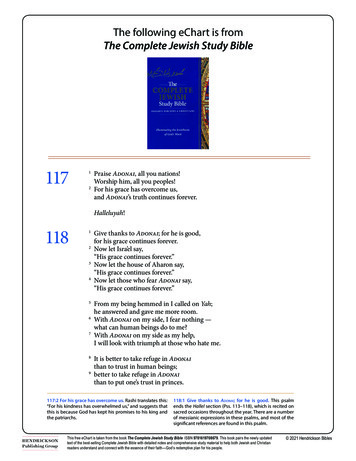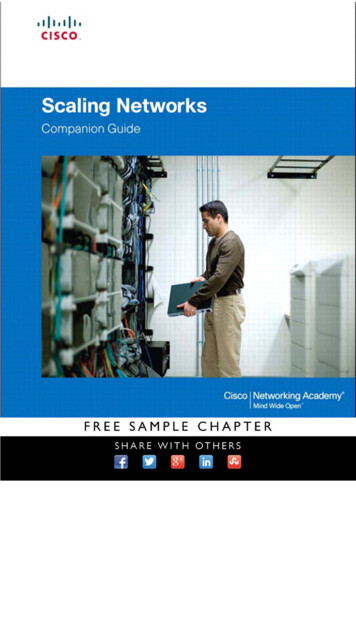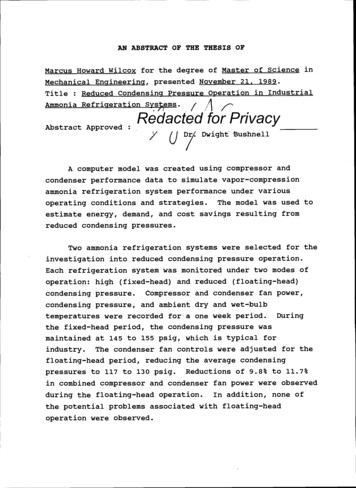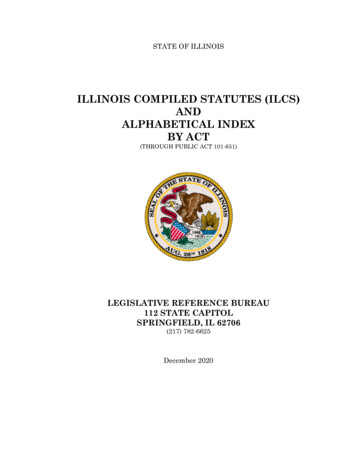
Transcription
The following eChart is fromThe Complete Jewish Study Bible1026 T E H I L L I M 1 1 6 : 1 51516171819From Adonai’s point of view,the death of those faithful to him is costly.Oh, Adonai! I am your slave;I am your slave, the son of your slave-girl;you have removed my fetters.I will offer a sacrifice of thanks to youand will call on the name of Adonai.I will pay my vows to Adonaiin the presence of all his people,in the courtyards of Adonai’s house,there in your very heart, Yerushalayim.Halleluyah!11712Praise Adonai, all you nations!Worship him, all you peoples!For his grace has overcome us,and Adonai’s truth continues forever.Halleluyah!118123456789Give thanks to Adonai; for he is good,for his grace continues forever.Now let Isra’el say,“His grace continues forever.”Now let the house of Aharon say,“His grace continues forever.”Now let those who fear Adonai say,“His grace continues forever.”From my being hemmed in I called on Yah;he answered and gave me more room.With Adonai on my side, I fear nothing —what can human beings do to me?With Adonai on my side as my help,I will look with triumph at those who hate me.It is better to take refuge in Adonaithan to trust in human beings;better to take refuge in Adonaithan to put one’s trust in princes.117:2 For his grace has overcome us. Rashi translates this:“For his kindness has overwhelmed us,” and suggests thatthis is because God has kept his promises to his king andthe patriarchs.118:1 Give thanks to ADONAI; for he is good. This psalmends the Hallel section (Pss. 113–118), which is recited onsacred occasions throughout the year. There are a numberof messianic expressions in these psalms, and most of thesignificant references are found in this psalm.This free eChart is taken from the book The Complete Jewish Study Bible ISBN 9781619708679. This book pairs the newly updatedtext of the best-selling Complete Jewish Bible with detailed notes and comprehensive study material to help both Jewish and Christianreaders understand and connect with the essence of their faith—God’s redemptive plan for his people. 2021 Hendrickson Bibles
PSALM 118:141011121314 10272The nations all surrounded me;in the name of Adonai I cut them down.They surrounded me on every sidein the name of Adonai I cut them down.They surrounded me like beesbut were extinguished [as quickly] as a fire in thorns;in the name of Adonai I cut them down.You pushed me hard to make me fall,but Adonai helped me.Yah is my strength and my song,and he has become my salvation.THE HOLY DAYS OF ISRA’ ELSukkot (Tabernacles): Traditional Jewish ObservancePsalm 118 The Torah stipulates the fifteenth day ofthe Jewish month Tishri as the time when the Jewishpeople are to begin dwelling in a booth (sukkah orsukkot, plural) and celebrating God’s provision. Thisholy day is so joyful that traditional Jews don’t evenwait for the fifteenth of Tishri to construct theirsukkot. Many begin the construction five days early,immediately after the close of Yom-Kippur.The construction of the sukkah can be bothchallenging and fun for the whole family. The Biblegives a rather general commandment to build asukkah. Essentially, it is a temporary hut in which oneis to live instead of in one’s permanent house. It musthave at least three walls, which may be of any material(wood, brick, or tarp). If the booth is constructednext to a house, it may incorporate one or more wallsof the house as its own. The most important part ofthe sukkah construction, the roof (called skhach) canbe anything that grows from the ground, such asbranches, wooden two-by-fours, and bushes.To emphasize its temporary status, the roof isarranged so the stars can be seen through it on a clearnight. Once the main construction of the sukkah iscompleted, the children contribute their part withartwork, fruit tied with string, or any other creativeideas they have. The sukkah is to be big enough tohouse at least one person, but preferably it should beable to hold a table for meals. If the climate is mildenough, then people sleep overnight in the hut.Once the sukkah is built and the holy day has arrived,there are other customs incorporated into thecelebration. Each evening of the eight-day festival,special blessings are said over the palm branch (lulav)and citron, a fruit from Isra’el called etrog. These twoitems, along with the myrtle (hadas) and willow(arava), form what is called “The Four Species.” Theyare wrapped together so the people can wave themin every direction, symbolizing the harvest and God’somnipresence.Many synagogues build a community sukkah to enableall worshippers to experience this greatest symbol ofSukkot. Special holy day services are held on the first andeighth days as required by the Torah. Because Sukkot isa time of joy, there are various processionals in whichthe congregants march around the aisles, waving palmbranches, and chanting from Psalm 118, Ana AdonaiHoshiana! (Save us Lord!). Thus, with thanksgiving, theJewish community seeks to remember the theme of thisholy day: God dwells with his people.For more on “The Holy Days of Isra’el: Sukkot(Tabernacles),” see reading at John 1:14.This free eChart is taken from the book The Complete Jewish Study Bible ISBN 9781619708679. This book pairs the newly updatedtext of the best-selling Complete Jewish Bible with detailed notes and comprehensive study material to help both Jewish and Christianreaders understand and connect with the essence of their faith—God’s redemptive plan for his people. 2021 Hendrickson Bibles
10283 T E H I L L I M 1 1 8 : 1 5151617181920212223242526The sound of rejoicing and victoryis heard in the tents of the righteous:“Adonai’s right hand struck powerfully!Adonai’s right hand is raised in triumph!Adonai’s right hand struck powerfully!”I will not die; no, I will liveand proclaim the great deeds of Yah!Yah disciplined me severely,but did not hand me over to death.Open the gates of righteousness for me;I will enter them and thank Yah.This is the gate of Adonai;the righteous can enter it.I am thanking you because you answered me;you became my salvation.The very rock that the builders rejectedhas become the cornerstone!This has come from Adonai,and in our eyes it is amazing.This is the day Adonai has made,a day for us to rejoice and be glad.Please, Adonai! Save us!Please, Adonai! Rescue us!Blessed is he who comes in the name of Adonai.We bless you from the house of Adonai.27Adonai is God, and he gives us light.Join in the pilgrim festival with branchesall the way to the horns of the altar.28You are my God, and I thank you.You are my God; I exalt you.Give thanks to Adonai; for he is good,for his grace continues forever.29118:22–23 The very rock that the builders rejected hasbecome the cornerstone! This is a significant passage: v.22 is quoted in four passages in the B’rit Hadashah (Luke20:17; Acts 4:11; 1 Pet. 2:4, 7). And there are two additional passages that quote this verse along with v. 23 (Matt.21:42; Mark 12:10–11). The leaders’ (“builders’ ”) rejectionof Yeshua the Messiah becomes a proof of his claim toMessiahship.118:26 Blessed is he who comes in the name of ADONAI. Theshouts of Baruch haba b’Shem ADONAI (“Blessed is he whocomes in the name of the Lord”) are recorded in a number of places in the Gospels (see Matt. 23:39; Mark 11:9;John 12:13). These are profound expressions of messianicsignificance. In fact, it was the way people of that day weretaught to welcome the Messiah. Sforno teaches that in thecourse of exile, many Jews became estranged from the Torah and no longer felt at home in their own heritage. Yetwith the coming of the Messiah, all those who strayed arewelcomed back and will bless the name of ADONAI.This free eChart is taken from the book The Complete Jewish Study Bible ISBN 9781619708679. This book pairs the newly updatedtext of the best-selling Complete Jewish Bible with detailed notes and comprehensive study material to help both Jewish and Christianreaders understand and connect with the essence of their faith—God’s redemptive plan for his people. 2021 Hendrickson Bibles
1517INTRODUCTION TOYochanan(JOHN)Christians often refer to the Gospel of John (written most likely between 60and 90 c.e.) as the Gospel of faith or love, and as the best introduction to thelife of Messiah Yeshua because of its profound portrayal of his deity. However,a typical Jewish reader might be troubled by this Gospel’s portrayal of therelationship between Yeshua and his Jewish contemporaries. As one Jewishcommentator notes, “The Gospel casts the Jews as a group in the role of theOther who resists and opposes the Gospel’s message of truth” (Reinhartz 20),and “for this reason, John’s Gospel has been called the most Jewish and [also]the most anti-Jewish of the Gospels” (Levine and Brettler 152).How can a thoroughly Jewish account simultaneously seem anti-Jewish?The key is in Yeshua’s harsh words about some of the Jewish authoritieswho opposed him in first-century Yerushalayim. However, these cannotlegitimately be applied to the Jewish people as a whole. Moreover, theargument reflects the language of the Jewish Nevi’im (Prophets), and Yeshuadebates as a Jew among Jews. Using “we,” he identifies with the Jews andinsists on the unique place of the Jews in God’s purposes. Yeshua’s conflictwith religious authorities arises from his claim of identity with God, whichthis Gospel emphasizes more than the others. As the story unfolds, seventimes Yeshua uses the Greek phrase ego eimi, “I Am,” reflecting God’s selfdescription in the Septuagint (Exodus 3:13–15).The Gospel of John displays deep familiarity with first-century Jewish lifeand traditions. Speaking as a Jew of the Second Temple period, the authorexplains Jewish customs (2:6), reflects the use of midrash common tofirst-century Jewish commentators, and weaves Jewish holy days into hisnarrative. This backdrop frames Yeshua’s miracles and teaching.OutlineI.The Son of God ArrivesA. A prologue . . . . . . . . . . . . . . . . . . . . . . . . . . . . . . . . . . . . . . . . . . . . . . . . . . . . . . . . . . . . . 1:1–18B. Early ministry. . . . . . . . . . . . . . . . . . . . . . . . . . . . . . . . . . . . . . . . . . . . . . . . . . . . . . . . . . . 1:19–2:25II. The Son of God MinistersA. A Pharisee, a Samaritan woman . . . . . . . . . . . . . . . . . . . . . . . . . . . . . . . . . . . . . . . . . 3:1–4:42B. Healings, teachings, miracles . . . . . . . . . . . . . . . . . . . . . . . . . . . . . . . . . . . . . . . . . . . 4:43–10:42C. Raising El‘azar . . . . . . . . . . . . . . . . . . . . . . . . . . . . . . . . . . . . . . . . . . . . . . . . . . . . . . . . . . 11:1–57III. The Son of God Dies to SaveA. The final week. . . . . . . . . . . . . . . . . . . . . . . . . . . . . . . . . . . . . . . . . . . . . . . . . . . . . . . . . . 12:1–50B. The Last Seder . . . . . . . . . . . . . . . . . . . . . . . . . . . . . . . . . . . . . . . . . . . . . . . . . . . . . . . . . . 13:1–17:26C. Yeshua’s arrest and trial . . . . . . . . . . . . . . . . . . . . . . . . . . . . . . . . . . . . . . . . . . . . . . . . . 18:1–19:16D. The crucifixion and burial . . . . . . . . . . . . . . . . . . . . . . . . . . . . . . . . . . . . . . . . . . . . . . . 19:17–42IV. The Son of God Rises AgainA. Yeshua is alive . . . . . . . . . . . . . . . . . . . . . . . . . . . . . . . . . . . . . . . . . . . . . . . . . . . . . . . . . . 20:1–31B. Yeshua’s encounter with the talmidim . . . . . . . . . . . . . . . . . . . . . . . . . . . . . . . . . . . 21:1–25This free eChart is taken from the book The Complete Jewish Study Bible ISBN 9781619708679. This book pairs the newly updatedtext of the best-selling Complete Jewish Bible with detailed notes and comprehensive study material to help both Jewish and Christianreaders understand and connect with the essence of their faith—God’s redemptive plan for his people. 2021 Hendrickson Bibles
5The Good News of Yeshua the Messiah,as Reported byYochananJOHN112In the beginning was the Word,and the Word was with God,and the Word was God.He was with God in the beginning.3All things came to be through him,and without him nothing made had being.4In him was life,and the life was the light of mankind.5The light shines in the darkness,and the darkness has not suppressed it.There was a man sent from God whose name was Yochanan. 7 He came to be a testimony,to bear witness concerning the light; so that through him, everyone might put his trust inGod and be faithful to him. 8 He himself was not that light; no, he came to bear witnessconcerning the light.61:1a In the beginning was the Word. This echoes the firstsentence of Genesis: “In the beginning God created theheavens and the earth.” The Word is not named as such inGenesis but is immediately seen in action: “And God said,‘Let there be light’ ” (Gen. 1:3). God expresses himself ascommanding, calling, and creating. This expressing, thisspeaking, this “Word” is God. A God who does not speak, awordless God, is no God at all. Word, from the Greek logos,corresponds to the Aramaic memra, a technical, theological term used by rabbis in the centuries before and afterYeshua when speaking of God’s expression of himself.Thus the Messiah existed before all creation (cf. 17:5).1:1b-2 And the Word was with God, and the Word wasGod. Some qualities of Yochanan (John) that have beenconsidered non-Jewish or of Hellenistic origin in the pastare better understood in a Jewish context. One exampleis its famous use of the Greek term logos: “In the begin-ning was the Word [logos], and the Word was with God,and the Word was God.” F. F. Bruce notes, “The term logoswas familiar in some Greek philosophical schools,” and“constituted a bridge-word by which people brought up inGreek philosophy.found their way into Johannine Christianity.” At the same time, “The true background to John’sthought and language is found not in Greek philosophybut in Hebrew revelation” (Bruce, The Gospel of John 29).John’s use of logos is rooted in the creation account ofGenesis and parallel Jewish discussions of personified wisdom (Pr. 8:22ff.) and of the Aramaic term memra or word.Another example is John’s frequent use of stark contrast,as between light and darkness (1:5ff.; 3:19–21; 12:35–36)or above and below (8:23). As with logos, this usage hasbeen explained in terms of Greek philosophy, which wasdualistic, but it actually reflects streams of Second TempleJewish thought, in particular, the Dead Sea Scrolls.This free eChart is taken from the book The Complete Jewish Study Bible ISBN 9781619708679. This book pairs the newly updatedtext of the best-selling Complete Jewish Bible with detailed notes and comprehensive study material to help both Jewish and Christianreaders understand and connect with the essence of their faith—God’s redemptive plan for his people. 2021 Hendrickson Bibles
J O H N 1 : 1 5 615199This was the true light,which gives light to everyone entering the world.10He was in the world — the world came to be through him —yet the world did not know him.11He came to his own homeland,yet his own people did not receive him.But to as many as did receive him, to those who put their trust in his person and power,he gave the right to become children of God, 13 not because of bloodline, physical impulseor human intention, but because of God.1214The Word became a human being and lived with us,and we saw his Sh’khinah,the Sh’khinah of the Father’s only Son,full of grace and truth.Yochanan witnessed concerning him when he cried out, “This is the man I was talkingabout when I said, ‘The one coming after me has come to rank ahead of me, because heexisted before me.’ ”15The Sh’khinahJohn 1:14The Sh’khinah (Divine Presence) is the manifestation of God that descended to “dwell” amonghumanity. Like memra (word or logos), the rabbisused the term euphemistically in place of YHVH,the Holy Name of “God.” The word itself is takenfrom passages that speak of God dwelling in theTabernacle or being among the people of Isra’el(Exod. 25:8; 29:45–46; Num. 35:34; 1 Kings 6:13;1:11 His own homeland his own people. “His own homeland” and “people” could be either the world and humanity or the Land of Isra’el and the Jewish people; the latterseems more relevant since he spent his entire life in or nearEretz-Isra’el. Yet Yeshua, the Living Word (v. 10), created theentire world, so the entire world could well be in view here.1:12 The right to become children of God. Here being a“child of God” means having an intimate personal relationship with him, as did Avraham (Abraham), Yitz’chak (Isaac),Ya‘akov (Jacob), Moshe (Moses), and David.Ezek. 43:9; Zech. 2:1–4). The Sh’khinah is brought toits fullness with the incarnation of Yeshua in John1:14, which states, “The Word became a humanbeing and lived with us, and we saw his Sh’khinah,the Sh’khinah of the Father’s only Son, full of graceand truth.” This further reinforces the idea that inMessiah, God dwells with people (cf. 2 Cor. 6:16;John 14:23).1:14 The Word became a human being. Literally, “TheWord became flesh.” Yeshua, who grew up in Nazareth, didnot decide he would be God, but rather the logos who “waswith God” and “was God,” gave up the “glory [he] had with[the Father] before the world existed” (17:5) and “emptiedhimself, and took on the form of a slave by becoming likehuman beings are.” In the incarnation, Yeshua as bothADONAI and the Word came to earth as a man. The Tanakhreports many instances of God’s appearance as a man—toAvraham (Gen. 18), Ya‘akov (Gen. 32:25–33), Moshe (Exod.3), the people of Isra’el (Judg. 2:1–5), and others.This free eChart is taken from the book The Complete Jewish Study Bible ISBN 9781619708679. This book pairs the newly updatedtext of the best-selling Complete Jewish Bible with detailed notes and comprehensive study material to help both Jewish and Christianreaders understand and connect with the essence of their faith—God’s redemptive plan for his people. 2021 Hendrickson Bibles
71520YOCHANAN 1:1616We have all received from his fullness,yes, grace upon grace.THE HOLY DAYS OF ISRA’ ELSukkot (Tabernacles): New Testament ObservanceJohn 1:14 John 1:14 relates the special background ofMessiah, openly declaring the divine nature of Yeshua.The Word not only was with God in the beginning,but this Word is the very manifestation of God himself(John 1:1). This Word, as Yochanan (John) calls him,was manifested to the world in a practical and tangibleway: “The Word became a human being and lived withus, and we saw his Sh’khinah, the Sh’khinah of theFather’s only Son, full of grace and truth” (John 1:14).Yeshua of Nazareth is more than just a good rabbi or anintriguing philosopher. According to the Bible, he is thevisible manifestation of the invisible God of creation!To describe this incarnation, Yochanan employs theWord “dwelt” among his people. As Yochanan soughtto describe the Messiah’s first coming to his people,the most obvious picture was Sukkot, the holy day thatcelebrates the dwelling of God!The Talmud tells of a custom that developed in theSecond Temple period. At that time during this holyday, a priest would take a water pitcher down to thePool of Shiloach (Siloam), dip it in the water, and carryit back to the Temple. Crowds of people would thenform a huge processional behind the priest, dancing,singing, and chanting the Hallel Psalms (113–118)as they entered the Temple mount. For each of thefirst six days of Sukkot, the processional would circlethe Temple altar one time, and on the seventh daythere would be seven processionals to magnify thejoy. The highlight of the ceremony came when thepriest dramatically poured the water on the altar ofthe Temple. The response of the multitudes was soimmense that the Talmud says whoever has not beenin Yerushalayim for this ceremony has not experiencedreal joy. Hence, it became known as Rejoicing of theHouse of Drawing Water (Hoshana Rabbah).Why all the rejoicing at this water pouring ceremony?Obviously, it had to be more than the rejoicing in thehope of future winter rains for Isra’el, as importantas that might be. Talmudic rabbis speak of deepertruths from Isaiah 12:3 in regard to the ceremony:“Then you will joyfully draw water from the springsof salvation” (salvation in Hebrew is yeshua, thename of the Messiah). More than the outpouring oftemporal water in Isra’el, the Rejoicing of the House ofDrawing Water was to prophetically illustrate the daysof messianic redemption when the water of the HolySpirit would be poured out upon all Isra’el. God willultimately build his habitation with his people whenthe kingdom is established under Messiah’s rule. John7:37–39 explains the next connection to Sukkot in theNew Testament:Now on the last day of the festival, HoshanaRabbah, Yeshua stood and cried out, “If anyone isthirsty, let him keep coming to me and drinking!Whoever puts his trust in me, as the Scripturesays, rivers of living water will flow from hisinmost being.” (Now he said this about theSpirit, whom those who trusted in Him were toreceive later—the Spirit had not yet been given,because Yeshua had not yet been glorified.)Imagine the setting: Sukkot was in full swing, and thejoy of the first six days was exuberant. On the greatfinal day (Hoshana Rabbah), the crowds were filledwith expectation for the Messiah and the Holy Spirithe would bring. At the very time of the water-drawingceremony, Yeshua made a bold proclamation: “Doyou truly want the living waters of the Holy Spirit?Does anyone understand the true significance of thisceremony? If anyone desires what the Bet Ha-sho-evahsymbolizes, let him believe in me. I am the Messiahwho will pour out the Holy Spirit on Isra’el!”For more on “The Holy Days of Isra’el: Sukkot(Tabernacles),” see reading at Revelation 21:1–3.This free eChart is taken from the book The Complete Jewish Study Bible ISBN 9781619708679. This book pairs the newly updatedtext of the best-selling Complete Jewish Bible with detailed notes and comprehensive study material to help both Jewish and Christianreaders understand and connect with the essence of their faith—God’s redemptive plan for his people. 2021 Hendrickson Bibles
Feasts of the Bible, PamphletGod commanded Moses and the Children of Israel toobserve these feasts and holy days as memorials to the greatthings that he had done in their lives. These are holidays thatJesus observed all through his life. See how these specialdays point to Jesus as the promised Messiah.Pamphlet. 9781890947583. 3.99100 Prophecies Fulfilled by JesusStudents will be amazed to discover that Jesus fulfilledmore than 100 prophecies that were foretold by the OldTestament prophets 400-1500 years before He was bornconcerning His birth, life, ministry, death, and resurrection.Unfolds to 33” long. Fits easily in most Bibles.Pamphlet. 9781890947194 . 3.99The Complete Jewish Study BibleThe Complete Jewish Study Bible pairs the newly updated textof the best-selling Complete Jewish Bible with detailed notes andcomprehensive study material to help both Jewish and Christianreaders understand and connect with the essence of their faith—God’s redemptive plan for his people. Readers will be enrichedthrough this Jewish reading of Scripture and the revelation of thelong-awaited Messiah, Yeshua, throughout both the Tanakh (OldTestament) and the B’rit Hadashah (New Testament).Book.9781619708679. 49.95The Twelve Disciples PamphletThis pamphlet contains: General information, shortbiographies on the personality and character of the twelvedisciples, encounters with Jesus, Scripture References,key lessons, stories. A fine catalogue of thumbnailsketches of the disciples.Pamphlet . 9781890947934 . 3.99www.hendricksonrose.com info@hendricksonrose.comor call (800) 358-3111This free eChart is taken from the book The Complete Jewish Study Bible ISBN 9781619708679. This book pairs the newly updated text of the best-selling Complete 2019 Rose Publishing, LLC. You may print 10 copies,Rose Publishing,LLC., publishesBible e linesand biblicalreferencefor faith—God’spastors, Bible studynewonmemberclasses& viasmallgroups.Jewish Biblefull-color,with detailedeasy-to-usenotes and comprehensivestudy materialto helpboth Jewishand Christianunderstandand connectwith thepamphletsessence of theirbutleaders,do not postthe internetor sendemail.redemptive plan for his people.
This free eChart is taken from the book The Complete Jewish Study Bible ISBN 9781619708679 . This book pairs the newly updated text of the best-selling Complete Jewish Bible with detailed notes and comprehensive study material to help both Jewish and Christian










